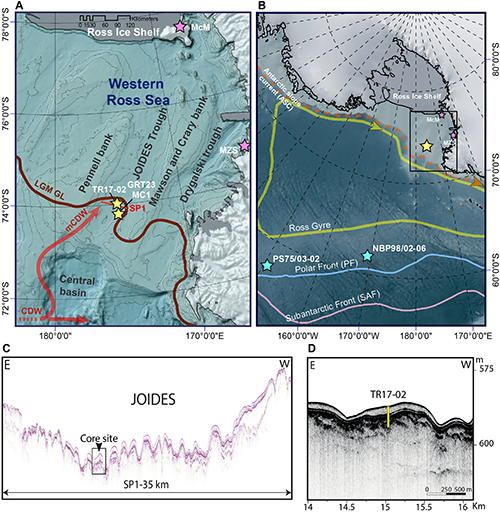Past intrusion of Circumpolar Deep Water in the Ross Sea: Impacts on the ancient Ross Ice Shelf

(A) Focus on the JOIDES Trough with respect to the position of cores TR17-02 and GRT23-MC1 over the seismic profile SP1 (red line, fig. S1). The brown line indicates the maximum extent of the ice sheet at the LGM sourced by QAntarctica dataset (81). The image highlights the path of CDW from the slope to the shelf, evolving into modified CDW [modified after Morrison et al. (23) and Bollen et al. (22)]. Pink stars on the coastal area refer to the Antarctic stations Mario Zucchelli (MZS) and McMurdo (McM). (B) Map of the Ross Sea showing the main oceanic features, the Ross Gyre (yellow solid line), the Polar Front (PF; blue solid line), and the subantarctic front (SAF, pink solid line) sourced by QAntarctica on QGis (81). Light blue stars indicate two key sediment cores, PS75/03-02 (18) and NBP98/02-06 (17), which were essential for determining the timing of upwelling dynamics in the polar front. Pink stars refer to the Antarctic stations Mario Zucchelli and McMurdo. (C) Transversal seismic profile SP1 depicts the geomorphology of the JOIDES Trough at the coring site, evidencing the large scouring of the submarine topography and the thickness of the sediments (see fig. S1). (D) Zoom over the coring site, showing the position of core TR17-02 and sedimentary thickness (see fig. S1).
Pambianco C., A. Nogarotto, M Sabino, L. Capotondi, F. Battaglia, F. Giglio, G. Mollenhauer, J. Hefter, A. Di Roberto,
S.T. Belt, E. Pochini, F. Muschitiello, A. Geniram, E. Colizza, G. Giorgetti, F. Torricella, T. Tesi, (2025).
Science Advances, 11(26). https://doi.org/10.1126/sciadv.adt7075
Abstract
The Ross Ice Shelf, Antarctica’s largest by area, may face increased instability under future warming, threatening the Antarctic Ice Sheet. Understanding its past response to climate change is critical for anticipating future sea-level rise. We present a multi-proxy reconstruction of ocean and cryosphere conditions in the Ross Sea over the past 40,000 years. Our data show that warm Circumpolar Deep Water reached the JOIDES Trough in the western Ross Sea shortly after the Last Glacial Maximum, coinciding with the retreat of an ancestral ice shelf. This oceanic warming aligns with a southward shift of both the westerly and easterly wind belts, indicating a large-scale atmospheric mechanism driving regional ocean changes. The timing and nature of these processes reveal the tight coupling between atmospheric circulation, ocean heat transport, and ice shelf dynamics. These interactions led to reduced ice shelf extent, highlighting the role of ocean-atmosphere coupling in the Pacific sector of the Southern Ocean during deglaciation.



Devi effettuare l'accesso per postare un commento.